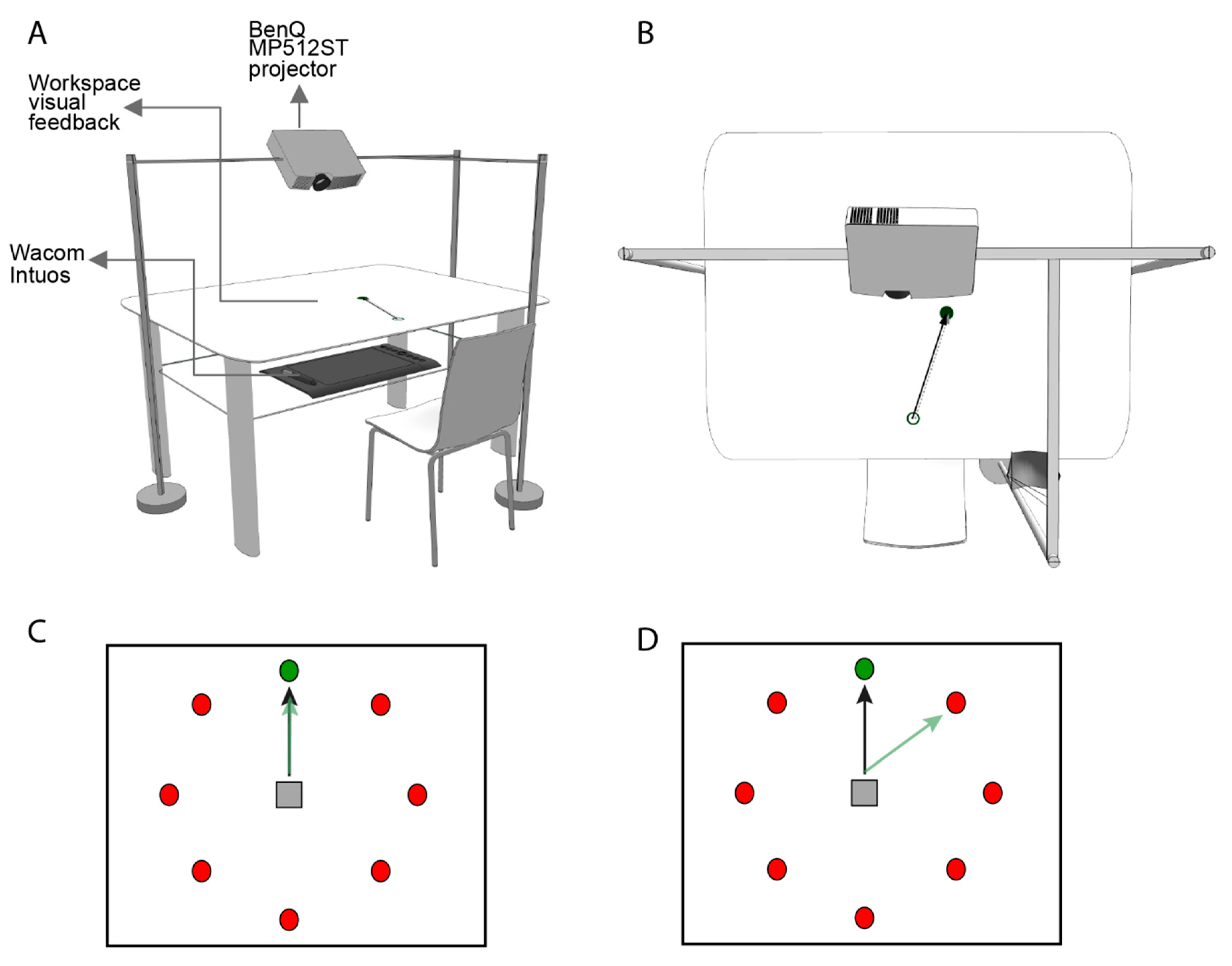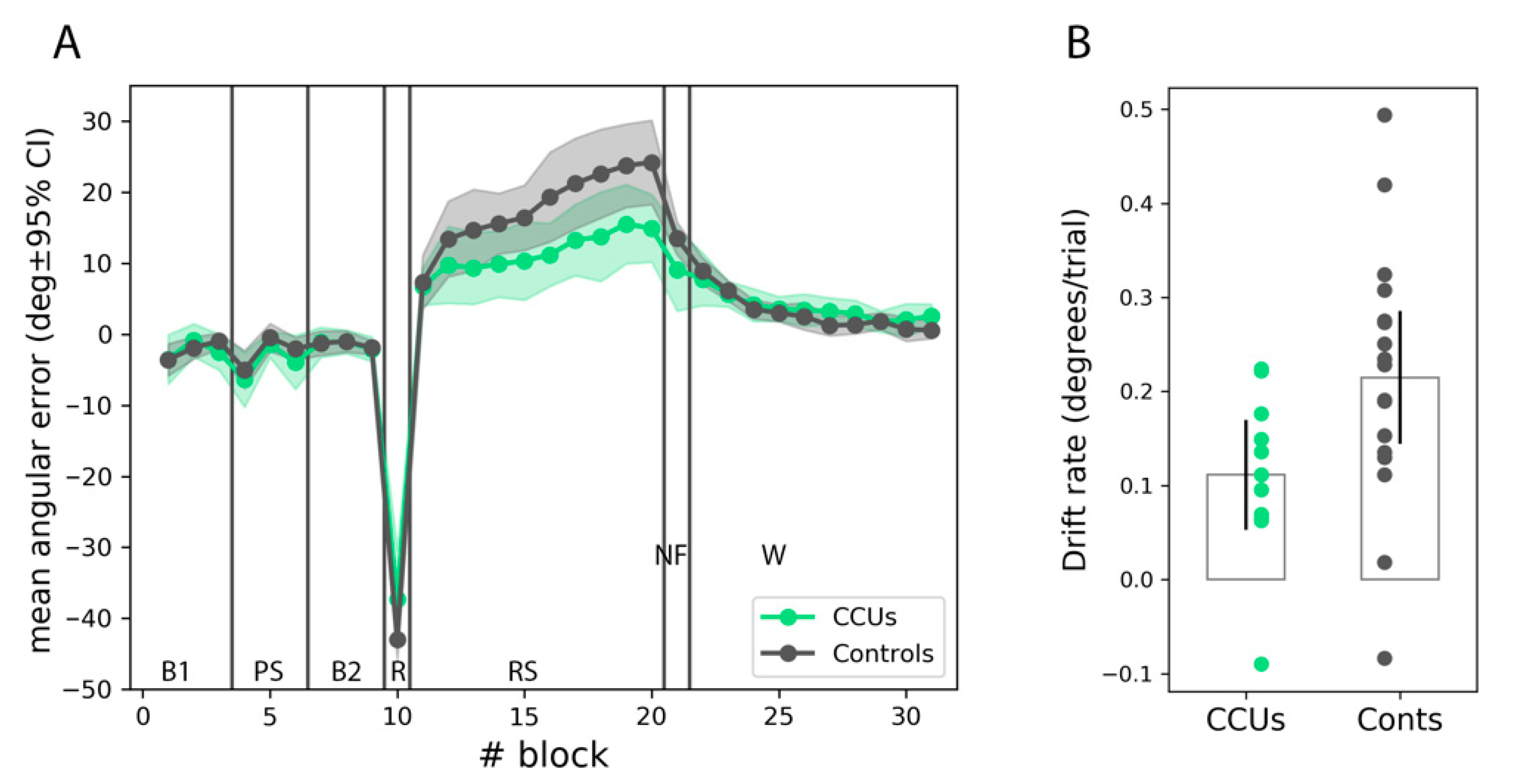Motor Adaptation Impairment in Chronic Cannabis Users Assessed by a Visuomotor Rotation Task
Abstract
:1. Introduction
2. Experimental Section
2.1. Design
2.2. Participants
2.3. Procedures
2.4. Analysis
3. Results
4. Discussion
5. Conclusions
Author Contributions
Funding
Acknowledgments
Conflicts of Interest
References
- UNODC. World Drug Report. 2016. Available online: https://www.unodc.org/wdr2016/ (accessed on 16 July 2019).
- Al-Imam, A. The Most Popular Chemical Categories of NPS in Four Leading Countries of the Developed World: An Integrative Analysis of Trends Databases, Surface Web, and the Deep Web. Glob. J. Health Sci. 2017, 9, 40. [Google Scholar] [CrossRef]
- Koziol, L.F.; Budding, D.; Andreasen, N.; Darrigo, S.; Bulgheroni, S.; Imamizu, H.; Ito, M.; Manto, M.; Marvel, C.; Parker, K.; et al. Consensus Paper: The Cerebellum’s Role in Movement and Cognition. Cerebellum 2014, 13, 151–177. [Google Scholar] [CrossRef] [PubMed]
- Miquel, M.; Vazquez-Sanroman, D.; Carbo-Gas, M.; Gil-Miravet, I.; Sanchis-Segura, C.; Carulli, D.; Manzo, J.; Coria-Avila, G.A. Have we been ignoring the elephant in the room? Seven arguments for considering the cerebellum as part of addiction circuitry. Neurosci. Biol. Rev. 2016, 60, 1–11. [Google Scholar] [CrossRef] [PubMed] [Green Version]
- Hasin, D.S.; Sarvet, A.L.; Cerdá, M.; Keyes, K.M.; Stohl, M.; Galea, S.; Wall, M.M. US Adult Illicit Cannabis Use, Cannabis Use Disorder, and Medical Marijuana Laws1991–1992 to 2012–2013. JAMA Psychiatry 2017, 74, 579–588. [Google Scholar] [CrossRef] [PubMed]
- Hall, W.; Weier, M. Assessing the Public Health Impacts of Legalizing Recreational Cannabis Use in the USA. Clin. Pharmacol. Ther. 2015, 97, 607–615. [Google Scholar] [CrossRef] [PubMed]
- Volkow, N.D.; Swanson, J.M.; Evins, A.E.; DeLisi, L.E.; Meier, M.H.; Gonzalez, R.; Bloomfield, M.A.P.; Curran, H.V.; Baler, R. Effects of cannabis use on human behavior, including cognition, motivation, and psychosis: A review. JAMA Psychiatry 2016, 73, 292–297. [Google Scholar] [CrossRef] [PubMed]
- Crane, N.A.; Schuster, R.M.; Fusar-Poli, P.; Gonzalez, R. Effects of cannabis on neurocognitive functioning: Recent advances, neurodevelopmental influences, and sex differences. Neuropsychol. Rev. 2013, 23, 117–137. [Google Scholar] [CrossRef]
- Ramaekers, J.; Kauert, G.; Theunissen, E.; Toennes, S.; Moeller, M. Neurocognitive performance during acute THC intoxication in heavy and occasional cannabis users. J. Psychopharmacol. 2009, 23, 266–277. [Google Scholar] [CrossRef]
- Meier, M.H.; Caspi, A.; Ambler, A.; Harrington, H.; Houts, R.; Keefe, R.S.E.; McDonald, K.; Ward, A.; Poulton, R.; Moffitt, T.E. Persistent cannabis users show neuropsychological decline from childhood to midlife. Proc. Natl. Acad. Sci. USA. 2012, 109, E2657–E2664. [Google Scholar] [CrossRef]
- Prashad, S.; Filbey, F.M. Cognitive motor deficits in cannabis users. Curr. Opin. Behav. Sci. 2017, 13, 1–7. [Google Scholar] [CrossRef]
- Ramaekers, J.G.; Kauert, G.; van Ruitenbeek, P.; Theunissen, E.L.; Schneider, E.; Moeller, M.R. High-Potency Marijuana Impairs Executive Function and Inhibitory Motor Control. Neuropsychopharmacology 2006, 31, 2296–2303. [Google Scholar] [CrossRef] [PubMed] [Green Version]
- Hall, W. What has research over the past two decades revealed about the adverse health effects of recreational cannabis use? Addiction 2015, 110, 19–35. [Google Scholar] [CrossRef] [PubMed]
- Gaoni, Y.; Mechoulam, R. Isolation, structure, and partial synthesis of an active constituent of hashish. J. Am. Chem. Soc. 1964, 86, 1646–1647. [Google Scholar] [CrossRef]
- Matsuda, L.; Lolait, S.; Brownstein, M.; Young, A.; Bonner, T. Structure of a cannabinoid receptor and functional expression of the cloned cDNA. Nature 1990, 346, 561–564. [Google Scholar] [CrossRef] [PubMed]
- Devane, W.A.; Dysarz, F.A.; Johnson, M.R.; Melvin, L.S.; Howlett, A.C. Determination and characterization of a cannabinoid receptor in rat brain. Mol. Pharmacol. 1988, 34, 605–613. [Google Scholar] [PubMed]
- Kano, M.; Ohno-Shosaku, T.; Hashimotodani, Y.; Uchigashima, M.; Watanabe, M. Endocannabinoid-mediated control of synaptic transmission. Physiol. Rev. 2009, 89, 309–380. [Google Scholar] [CrossRef] [PubMed]
- Cadogan, A.K.; Alexander, S.P.; Boyd, E.A.; Kendall, D.A. Influence of cannabinoids on electrically evoked dopamine release and cyclic AMP generation in the rat striatum. J. Neurochem. 1997, 69, 1131–1137. [Google Scholar] [CrossRef] [PubMed]
- Tsou, K.; Brown, S.; Sañudo-Peña, M.; Mackie, K.; Walker, J. Immunohistochemical distribution of cannabinoid CB1 receptors in the rat central nervous system. Neuroscience 1998, 83, 393–411. [Google Scholar] [CrossRef]
- Egertova, M.; Elphick, M.R. Localisation of cannabinoid receptors in the rat brain using antibodies to the intracellular C-terminal tail of CB1. J. Comp. Neurol. 2000, 422, 159–171. [Google Scholar] [CrossRef]
- Cutando, L.; Busquets-Garcia, A.; Puighermanal, E.; Gomis-González, M.; Delgado-García, J.M.; Gruart, A.; Maldonado, R.; Ozaita, A. Microglial activation underlies cerebellar deficits produced by repeated cannabis exposure. J. Clin. Investig. 2013, 123, 2816–2831. [Google Scholar] [CrossRef]
- Safo, P.K.; Regehr, W.G. Endocannabinoids control the induction of cerebellar LTD. Neuron 2005, 48, 647–659. [Google Scholar] [CrossRef] [PubMed]
- Hesslow, G.; Yeo, C.H. The functional anatomy of skeletal conditioning. In A Neuroscientist’s Guide to Classical Conditioning; Springer: Berlin, Germany, 2002; pp. 86–146. [Google Scholar]
- Kishimoto, Y. Endogenous Cannabinoid Signaling through the CB1 Receptor Is Essential for Cerebellum-Dependent Discrete Motor Learning. J. Neurosci. 2006, 26, 8829–8837. [Google Scholar] [CrossRef] [PubMed] [Green Version]
- Skosnik, P.D.; Edwards, C.R.; O’Donnell, B.F.; Steffen, A.; Steinmetz, J.E.; Hetrick, W.P. Cannabis use disrupts eyeblink conditioning: Evidence for cannabinoid modulation of cerebellar-dependent learning. Neuropsychopharmacology 2008, 33, 1432–1440. [Google Scholar] [CrossRef] [PubMed]
- Shadmehr, R.; Smith, M.A.; Krakauer, J.W. Error correction, sensory prediction, and adaptation in motor control. Annu. Rev. Neurosci. 2010, 33, 89–108. [Google Scholar] [CrossRef] [PubMed]
- Herreros, I.; Verschure, P.F.M.J. Nucleo-olivary inhibition balances the interaction between the reactive and adaptive layers in motor control. Neural Netw. 2013, 47, 64–71. [Google Scholar] [CrossRef] [PubMed]
- Krakauer, J.W.; Pine, Z.M.; Ghilardi, M.F.; Ghez, C. Learning of visuomotor transformations for vectorial planning of reaching trajectories. J. Neurosci. 2000, 20, 8916–8924. [Google Scholar] [CrossRef] [PubMed]
- Mazzoni, P.; Krakauer, J.W. An Implicit Plan Overrides an Explicit Strategy during Visuomotor Adaptation. J. Neurosci. 2006, 26, 3642–3645. [Google Scholar] [CrossRef] [PubMed]
- Weiner, M.J.; Hallett, M.; Funkenstein, H.H. Adaptation to lateral displacement of vision in patients with lesions of the central nervous system. Neurology 1983, 33, 766–772. [Google Scholar] [CrossRef] [PubMed]
- Schlerf, J.E.; Xu, J.; Klemfuss, N.M.; Griffiths, T.L.; Ivry, R.B. Individuals with cerebellar degeneration show similar adaptation deficits with large and small visuomotor errors. J. Neurophysiol. 2013, 109, 1164–1173. [Google Scholar] [CrossRef]
- Taylor, J.A.; Klemfuss, N.M.; Ivry, R.B. An explicit strategy prevails when the cerebellum fails to compute movement errors. Cerebellum 2010, 9, 580–586. [Google Scholar] [CrossRef]
- Bonn-Miller, M.O.; Heinz, A.J.; Smith, E.V.; Bruno, R.; Adamson, S. Preliminary Development of a Brief Cannabis Use Disorder Screening Tool: The Cannabis Use Disorder Identification Test Short-Form. Cannabis Cannabinoid Res. 2016, 1, 252–261. [Google Scholar] [CrossRef] [PubMed]
- Casajuana, C.; Balcells-Olivero, M.M.; López-Pelayo, H.; Miquel, L.; Teixidó, L.; Colom, J.; Nutt, D.J.; Rehm, J.; Gual, A. The Standard Joint Unit. Drug Alcohol Depend. 2017, 1, 109–116. [Google Scholar] [CrossRef] [PubMed]
- Weyer, A.; Abele, M.; Schmitz-Hübsch, T.; Schoch, B.; Frings, M.; Timmann, D.; Klockgether, T. Reliability and validity of the scale for the assessment and rating of ataxia: A study in 64 ataxia patients. Mov. Disord. 2007, 22, 1633–1637. [Google Scholar] [CrossRef] [PubMed]
- Crean, R.D.; Crane, N.A.; Mason, B.J. An evidence based review of acute and long-term effects of cannabis use on executive cognitive functions. J. Addict. Med. 2011, 5, 1–8. [Google Scholar] [CrossRef] [PubMed]
- Taylor, J.A.; Ivry, R.B. Flexible cognitive strategies during motor learning. PLoS Comput. Biol. 2011, 7, e1001096. [Google Scholar] [CrossRef] [PubMed]
- Taylor, J.A.; Krakauer, J.W.; Ivry, R.B. Explicit and implicit contributions to learning in a sensorimotor adaptation task. J. Neurosci. 2014, 34, 3023–3032. [Google Scholar] [CrossRef] [PubMed]
- Beason-Held, L.L.; Goh, J.O.; An, Y.; Kraut, M.A.; O’Brien, R.J.; Ferrucci, L.; Resnick, S.M. Changes in brain function occur years before the onset of cognitive impairment. J. Neurosci. 2013, 33, 18008–18014. [Google Scholar] [CrossRef]
- Nakamura, A.; Cuesta, P.; Kato, T.; Arahata, Y.; Iwata, K.; Yamagishi, M.; Kuratsubo, I.; Kato, K.; Bundo, M.; Diers, K.; et al. Early functional network alterations in asymptomatic elders at risk for Alzheimer’s disease. Sci. Rep. 2017, 7, 6517. [Google Scholar] [CrossRef]
- Nestoros, J.N.; Vakonaki, E.; Tzatzarakis, M.N.; Alegakis, A.; Skondras, M.D.; Tsatsakis, A.M. Long lasting effects of chronic heavy cannabis abuse. Am. J. Addict. 2017, 26, 335–342. [Google Scholar] [CrossRef]
- Blithikioti, C.; Miquel, L.; Batalla, A.; Rubio, B.; Maffei, G.; Herreros, I.; Gual, A.; Verschure, P.; Balcells-Oliveró, M. Cerebellar alterations in cannabis users: A systematic review. Addict. Biol. 2019. [Google Scholar] [CrossRef]
- Morehead, J.R.; Taylor, J.A.; Parvin, D.E.; Ivry, R.B. Characteristics of Implicit Sensorimotor Adaptation Revealed by Task-irrelevant Clamped Feedback. J. Cogn. Neurosci. 2017, 29, 1061–1074. [Google Scholar] [CrossRef] [PubMed] [Green Version]


| Experimental (n = 11) | Control (n = 17) | |||||||||
|---|---|---|---|---|---|---|---|---|---|---|
| n | % | Mean | SD | n | % | Mean | SD | χ2/t/fisher | p-Value | |
| Men | 7 | 63.6 | 9 | 52.9 | 0.3 | 0.6 | ||||
| Age | 28.3 | 8.1 | 30.7 | 7.1 | −0.8 | 0.41 | ||||
| Academic Level | 13.7 | <0.001 | ||||||||
| High school | 8 | 72.7 | 1 | 5.9 | ||||||
| University | 3 | 27.3 | 16 | 94.1 | ||||||
| Civil Status | 0.05 | 0.8 | ||||||||
| Single | 8 | 72.7 | 13 | 76.5 | ||||||
| Married | 3 | 27.3 | 4 | 23.5 | ||||||
| Age at first cannabis consumption | 16.6 | 3 | 15 | 2 | ||||||
| Age at regular cannabis use | 19 | 2.1 | ||||||||
| Regular cigarette smokers (yes) | 4 | 36.4 | 1 | 6.3 | 0.134 | 0.07 | ||||
| Frequency of Cannabis use last 6 months | ||||||||||
| 4 to 6 times per week | 2 | 18.2 | ||||||||
| Daily | 9 | 75.0 | ||||||||
| SJU/day last 6 months | 3.7 | 3.7 | ||||||||
| Frequency of Cannabis use last week | ||||||||||
| Never | 2 | 18.2 | ||||||||
| 2 to 3 times per week | 1 | 69.1 | ||||||||
| 4 to 6 times per week | 2 | 18.2 | ||||||||
| Daily | 6 | 54.5 | ||||||||
| SJU/day last week | 2 | 2.2 | ||||||||
| Standard drink units per week | 6.7 | 8.3 | 2.9 | 3.9 | 1.6 | 0.1 | ||||
| SARA | 0 | 0 | ||||||||
© 2019 by the authors. Licensee MDPI, Basel, Switzerland. This article is an open access article distributed under the terms and conditions of the Creative Commons Attribution (CC BY) license (http://creativecommons.org/licenses/by/4.0/).
Share and Cite
Herreros, I.; Miquel, L.; Blithikioti, C.; Nuño, L.; Rubio Ballester, B.; Grechuta, K.; Gual, A.; Balcells-Oliveró, M.; Verschure, P. Motor Adaptation Impairment in Chronic Cannabis Users Assessed by a Visuomotor Rotation Task. J. Clin. Med. 2019, 8, 1049. https://doi.org/10.3390/jcm8071049
Herreros I, Miquel L, Blithikioti C, Nuño L, Rubio Ballester B, Grechuta K, Gual A, Balcells-Oliveró M, Verschure P. Motor Adaptation Impairment in Chronic Cannabis Users Assessed by a Visuomotor Rotation Task. Journal of Clinical Medicine. 2019; 8(7):1049. https://doi.org/10.3390/jcm8071049
Chicago/Turabian StyleHerreros, Ivan, Laia Miquel, Chrysanthi Blithikioti, Laura Nuño, Belen Rubio Ballester, Klaudia Grechuta, Antoni Gual, Mercè Balcells-Oliveró, and Paul Verschure. 2019. "Motor Adaptation Impairment in Chronic Cannabis Users Assessed by a Visuomotor Rotation Task" Journal of Clinical Medicine 8, no. 7: 1049. https://doi.org/10.3390/jcm8071049
APA StyleHerreros, I., Miquel, L., Blithikioti, C., Nuño, L., Rubio Ballester, B., Grechuta, K., Gual, A., Balcells-Oliveró, M., & Verschure, P. (2019). Motor Adaptation Impairment in Chronic Cannabis Users Assessed by a Visuomotor Rotation Task. Journal of Clinical Medicine, 8(7), 1049. https://doi.org/10.3390/jcm8071049






